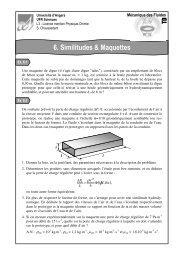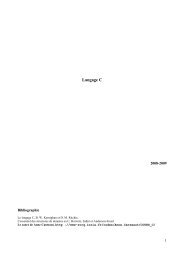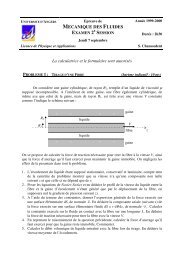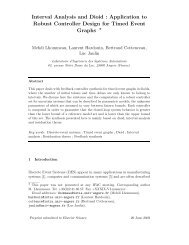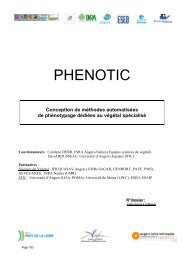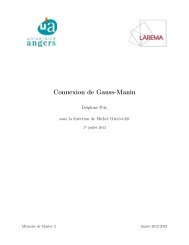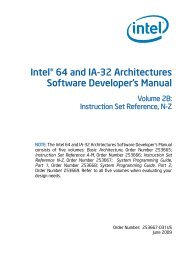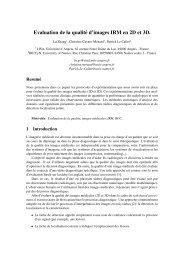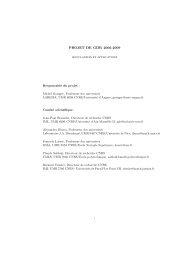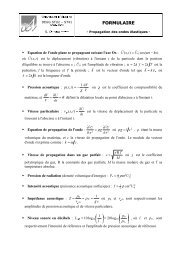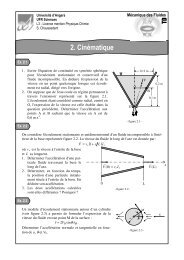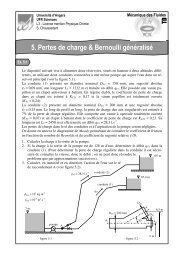Interval systems over idempotent semiring - ResearchGate
Interval systems over idempotent semiring - ResearchGate
Interval systems over idempotent semiring - ResearchGate
Create successful ePaper yourself
Turn your PDF publications into a flip-book with our unique Google optimized e-Paper software.
<strong>Interval</strong> <strong>systems</strong> <strong>over</strong> <strong>idempotent</strong> <strong>semiring</strong>Laurent Hardouin ∗Bertrand CottenceauMehdi LhommeauEuriell Le CorroncLaboratoire d’Ingénierie des Systèmes Automatisés,Université d’Angers,62, avenue Notre Dame du Lac, 49000 Angers, France.AbstractThis paper deals with solution of inequality A ⊗ x ≼ b, where A, x and b areinterval matrices with entries defined <strong>over</strong> <strong>idempotent</strong> <strong>semiring</strong>. It deals alsowith the computation of a pair of intervals, (x, y) which satisfies the equationA⊗x = B⊗y. It will be shown that this equation may be solved by consideringthe interval version of the iterative scheme proposed in [7].Key words: Max algebra; Idempotent <strong>semiring</strong>; <strong>Interval</strong> analysis; Residuationtheory;AMS classification : Primary 65G40 Secondary : 06F05, 15A09.1. IntroductionMany problems in the optimization theory and other fields of mathematicsare non-linear in the traditional sense but appear to be linear <strong>over</strong> <strong>idempotent</strong><strong>semiring</strong>s (e.g., see [1, 3, 6, 10]). Idempotency of the additive law induces∗ Corresponding authorEmail addresses: laurent.hardouin@univ-angers.fr (Laurent Hardouin),bertrand.cottenceau@univ-angers.fr (Bertrand Cottenceau),mehdi.lhommeau@univ-angers.fr (Mehdi Lhommeau), euriell.lecorronc@univ-angers.fr(Euriell Le Corronc)Preprint submitted to Elsevier March 16, 2009
that <strong>idempotent</strong> <strong>semiring</strong>s are (partially) ordered sets. The Residuation theory[2, 5, 8] is a suitable tool to deal with inverse problems of order preservingmappings. It is usually used to solve equations defined <strong>over</strong> <strong>idempotent</strong> <strong>semiring</strong>[1, 6, 7], for instance the greatest solution of inequality Ax ≼ b may be computedby means of this theory.<strong>Interval</strong> mathematics was pioneered by R.E. Moore (see [16]) as a tool forbounding rounding errors in computer programs. Since then, interval mathematicshas been developed into a general methodology for investigating numericaluncertainty in numerous problems and algorithms. In [14] the <strong>idempotent</strong>version is addressed. The authors show that <strong>idempotent</strong> interval mathematicsappears to be remarkably simpler than its traditional analog. For example, inthe traditional interval arithmetic, multiplication of intervals is not distributivewith respect to addition of intervals, while <strong>idempotent</strong> interval arithmetic keepsthis distributivity. This paper deals first with solution of inequality A ⊗ x ≼ b,where A, x and b are interval matrices (see proposition 31). When equality isachieved, according to definition given in [4], the equations system is said weaklysolvable since at least one of its sub<strong>systems</strong> is solvable. In a second step, thepaper deals with the computation of a pair of intervals, (x, y) which satisfiesthe equation A ⊗ x = B ⊗ y. It will be shown that this equation may be solvedby considering the interval version of the iterative scheme proposed in [7].2. PreliminariesDefinition 1. A <strong>semiring</strong> S is a set endowed with two internal operations denotedby ⊕ (addition) and ⊗ (multiplication), both associative and both havingneutral elements denoted by ε and e respectively, such that ⊕ is also commutativeand <strong>idempotent</strong> (i.e. a ⊕ a = a). The ⊗ operation is distributive withrespect to ⊕, and ε is absorbing for the product (i.e. ∀a, ε ⊗ a = a ⊗ ε = ε).When ⊗ is commutative, the <strong>semiring</strong> is said to be commutative.Semirings can be endowed with a canonical order defined by : a ≽ b iffa = a⊕b. Then they become sup-semilattices and a⊕b is the least upper bound2
of a and b. A <strong>semiring</strong> is complete if sums of infinite number of terms are alwaysdefined, and if multiplication distributes <strong>over</strong> infinite sums too. In particular,the sum of all elements of a complete <strong>semiring</strong> is defined and denoted by ⊤ (for’top’). A complete <strong>semiring</strong> (sup-semilattice) becomes a complete lattice forwhich the greatest lower bound of a and b is denoted a ∧ b, i.e., the least upperbound of the (nonempty) subset of all elements which are less than a and b (see[1, §4]).Example 2 ((max, +) algebra). The set Z = Z ∪ {−∞, +∞} endowed withthe max operator as ⊕ and the classical sum as ⊗ is a complete <strong>idempotent</strong><strong>semiring</strong> of which ε = −∞, e = 0 and ⊤ = +∞ and the greatest lower bounda ∧ b = min(a, b).Example 3 ((max, min) algebra). The set Z = Z∪{−∞, +∞} endowed withthe max operator as ⊕ and the min operator as ⊗ is a complete <strong>idempotent</strong><strong>semiring</strong> of which ε = −∞, e = +∞ and ⊤ = +∞ and the greatest lower bounda ∧ b = min(a, b).Definition 4 (Sub<strong>semiring</strong>). A subset C of a <strong>semiring</strong> is called a sub<strong>semiring</strong>of S if• ε ∈ C and e ∈ C ;• C is closed for ⊕ and ⊗, i.e, ∀a, b ∈ C, a ⊕ b ∈ C and a ⊗ b ∈ C.Definition 5 (Principal order ideal). Let S be an <strong>idempotent</strong> <strong>semiring</strong>. Anorder ideal set is a nonempty subset X of S such that (x ∈ X and y ≼ x) ⇒y ∈ X . A principal order ideal (generated by x) is an order ideal, denoted ↓ X x ,of the form ↓ X x := {y ∈ S|y ≼ x}.The residuation theory provides, under some assumptions, greatest solutionsto inequalities such as f(x) ≼ b where f is an order preserving mapping (i.e.,a ≼ b ⇒ f(a) ≼ f(b)) defined <strong>over</strong> ordered sets.Definition 6 (Residual and residuated mapping). An order preserving mappingf : D → E, where D and E are ordered sets, is a residuated mapping if for3
all y ∈ E, the least upper bound of the subset {x|f(x) ≼ y} exists and belongs tothis subset. It is then denoted by f ♯ (y). Mapping f ♯ is called the residual of f.When f is residuated, f ♯ is the unique order preserving mapping such thatf ◦ f ♯ ≼ Id E and f ♯ ◦ f ≽ Id D, (1)where Id is the identity mapping respectively on D and E.Property 7. Let f : D → E be a residuated mapping, theny ∈ Imf ⇔ f(f ♯ (y)) = y.Property 8 ([1, Th. 4.56]). If h : D → C and f : C → B are residuatedmappings, then f ◦ h is also residuated and(f ◦ h) ♯ = h ♯ ◦ f ♯ . (2)Theorem 9 ([1, §4.4.2]). Consider the mapping f : E → F where E and Fare complete <strong>semiring</strong>s. Their bottom elements are, respectively, denoted by ε Eand ε F . Then, f is residuated iff f(ε E ) = ε F and f( ⊕ x∈G x) = ⊕ x∈Gf(x) foreach G ⊆ E (i.e., f is lower-semicontinuous).Corrollary 10. The mappings L a : x ↦→ a ⊗ x and R a : x ↦→ x ⊗ a defined <strong>over</strong>a complete <strong>semiring</strong> S are both residuated. Their residuals are usually denoted,respectively, by L ♯ a(x) = a◦\x and Ra(x) ♯ = x◦/a in literature. Therefore, a◦\b(resp. b◦/a) is the greatest solution of a ⊗ x ≼ b (resp. x ⊗ a ≼ b). For matrices,the practical computation is obtained as follows,∧(A◦\B) ij= (A ki ◦\B kj ) , (3)(B◦/C) ij=k=1...n∧k=1...m(B ik ◦/C jk ) (4)with A ∈ S n×p , B ∈ S n×m and C ∈ S p×m .⎛ ⎞ ⎛ ⎞1 28Example 11. Let A = ⎜3 4⎟⎝ ⎠ and B = ⎜ 9 ⎟⎝ ⎠5 610(max, +) algebra.be matrices with entries in4
In (max, +) algebra a ij ◦\b j = b j − a ij then the greatest x such that A ⊗ x ≼ bis given by :⎛⎞ ⎛ ⎞(1◦\8) ∧ (3◦\9) ∧ (5◦\10)x = A◦\B = ⎝ ⎠ = ⎝ 5 ⎠(2◦\8) ∧ (4◦\9) ∧ (6◦\10) 4⎛ ⎞ ⎛ ⎞1 28Example 12. Let A = ⎜3 4⎟⎝ ⎠ and B = ⎜ 1 ⎟ be matrices with entries in⎝ ⎠5 610(max, min) algebra. In (max, min) algebra, if b j ≽ a ij then a ij ◦\b j = b j elsea ij ◦\b j = ⊤.⎛⎞ ⎛ ⎞(1◦\8) ∧ (3◦\1) ∧ (5◦\10)A◦\B = ⎝ ⎠ = ⎝ 8 ⎠(2◦\8) ∧ (4◦\1) ∧ (6◦\10) 8The problem of mapping restriction and its connection with the residuationtheory is now addressed.Property 13 ([2]). Let Id |Ssub : S sub → S, x ↦→ x be the canonical injectionfrom a complete sub<strong>semiring</strong> into a complete <strong>semiring</strong>. The injection Id |Ssub isresiduated and its residual is a projector which will be denoted by Pr Ssub , with :Pr Ssub = ( ) ♯Id |Ssub = Pr Ssub ◦ Pr Ssub .Definition 14 (Restricted mapping). Let f : E → F be a mapping andA ⊆ E. We will denote f |A : A → F the mapping defined by f |A = f ◦ Id |Awhere Id |A : A → E is the canonical injection from A to E. Similarly, let B ⊆ Fwith Imf ⊆ B. Mapping B| f : E → B is defined by f = Id |B ◦ B| f, whereId |B : B → F.Property 15. Let f : D → E be a residuated mapping and D sub (resp. E sub )be a complete sub<strong>semiring</strong> of D (resp. E).1. Mapping f |Dsub is residuated and its residual is given by :(f |Dsub ) ♯ = (f ◦ Id |Dsub ) ♯ = Pr Ssub ◦ f ♯ .2. If Imf ⊂ E sub then mapping Esub |f is residuated and its residual is given by:(E sub |f ) ♯= f ♯ ◦ Id |Esub = ( f ♯) |E sub.5
Proof. Statement 1 follows directly from property 8 and proposition 13. Statement2 is obvious since f is residuated and Imf ⊂ E sub ⊂ E.□In [7], the authors propose to compute a pair (x, y) satisfying the followingequation :a ⊗ x = b ⊗ y. (5)Theorems 16 and 17 given below recall how to compute such a pair, calledsimply a solution hereafter.Theorem 16. LetΠ : x ↦→ L ♯ a ◦ L b ◦ L ♯ b ◦ L a(x) = a◦\(b ⊗ (b◦\(a ⊗ x)))be a mapping defined <strong>over</strong> a <strong>semiring</strong> S and consider the following iterativescheme :Let x 0 ∈ S be an arbitrary elementdo x n+1 = Π(x n )until x m+1 = x m for m ∈ NIf function Π admits a fixed point x such that x ≼ Π(x 0 ) and x ≠ ε thenthe previous algorithm converges toward the greatest finite fixed point in thefollowing principal order ideal ↓ X Π(x0) = {x|x ≼ Π(x 0 )}.Proof. First let us recall that a lower-bounded non increasing integer sequenceconverges in a finite number of steps to the greatest fixed point. Then if functionΠ admits a fixed point x such that x ≼ Π(x 0 ) and x ≠ ε then it is sufficient toshow that the sequence x n (n = 1, 2, ..) is non increasing. Definition 6 yieldsthat L b ◦ L ♯ b ≼ Id and L a ◦ L ♯ a ≼ Id, then Π(x) ≼ L ♯ a ◦ L a (x) andΠ ◦ Π = L ♯ a ◦ L b ◦ L ♯ b ◦ L a ◦ L ♯ a ◦ L b ◦ L ♯ b ◦ L a (6)Π ◦ Π ≼ L ♯ a ◦ L b ◦ L ♯ b ◦ L a = Π (7)therefore x n+1 ≼ x n , i.e. the sequence is non increasing.Obviously if x n+1 = Π(x n ) then x n+1 ≼ Π(x 0 ), and it is the greatest in ↓ X Π(x0).□6
Theorem 17. Define y = L ♯ b ◦ L a(x) = b◦\(a ⊗ x). If the function Π defined intheorem 16 admits a fixed point x ≠ ε, then the pair (x, y) is a solution of (5).Proof. If x = Π(x) and y = L ♯ b ◦ L a(x) then, by using twice equation (1), weobtainL a (x) = L a ◦ L ♯ a ◦ L b ◦ L ♯ b ◦ L a(x) ≼ L b ◦ L ♯ b ◦ L a(x) = L b (y) ≼ L a (x).Therefore all these terms are equal, and a ⊗ x = L a (x) = L b (y) = b ⊗ y.□3. Semiring of intervalsA <strong>semiring</strong> of interval may be constructed by considering a <strong>semiring</strong> of pairs.The set of pairs (x ′ , x ′′ ) with x ′ ∈ S and x ′′ ∈ S endowed with the followingcoordinate-wise algebraic operations :(x ′ , x ′′ ) ⊕ (y ′ , y ′′ ) (x ′ ⊕ y ′ , x ′′ ⊕ y ′′ )and (x ′ , x ′′ ) ⊗ (y ′ , y ′′ ) (x ′ ⊗ y ′ , x ′′ ⊗ y ′′ ),is a <strong>semiring</strong> denoted by C(S) with (ε, ε) as the zero element and (e, e) as theidentity element (see definition 1). Some of the preliminary statements of thissection are adapted from [14].Remark 18. The operation ⊕ generates the corresponding canonical partialorder ≼ C in C(S) :(x ′ , x ′′ ) ⊕ (y ′ , y ′′ ) = (y ′ , y ′′ ) ⇔ (x ′ , x ′′ ) ≼ C (y ′ , y ′′ ) ⇔ x ′ ≼ S y ′ and x ′′ ≼ S y ′′where ≼ S is the order relation in S.Property 19. If the <strong>semiring</strong> S is complete, then the <strong>semiring</strong> C(S) is completeand its top element is given by (⊤, ⊤).Notation 20. Consider the following mappings <strong>over</strong> C(S) :L (a ′ ,a ′′ ) : (x ′ , x ′′ ) ↦→ (a ′ , a ′′ ) ⊗ (x ′ , x ′′ ) (left multiplication by (a ′ , a ′′ ))R (a ′ ,a ′′ ) : (x ′ , x ′′ ) ↦→ (x ′ , x ′′ ) ⊗ (a ′ , a ′′ ) (right multiplication by (a ′ , a ′′ )).Property 21. The mappings L (a ′ ,a ′′ ) and R (a ′ ,a ′′ ) defined <strong>over</strong> C(S) are bothresiduated. Their residuals are equal to L ♯ (a ′ ,a ′′ ) (b′ , b ′′ ) = (a ′ , a ′′ )◦\(b ′ , b ′′ ) =(a ′ ◦\b ′ , a ′′ ◦\b ′′ ) and R ♯ (a ′ ,a ′′ ) (b′ , b ′′ ) = (b ′ , b ′′ )◦/(a ′ , a ′′ ) = (b ′ ◦/a ′ , b ′′ ◦/a ′′ ).7
( ⊕ )Proof. Observe that L (a′ ,a ′′ ) (x ′ ,x ′′ )∈X (x′ , x ′′ ) = ⊕ (x ′ ,x ′′ )∈X L (a ′ ,a ′′ ) (x ′ , x ′′ ),(for every subset X of C(S)), more<strong>over</strong> L (a′ ,a ′′ )(ε, ε) = (a ′ ⊗ ε, a ′′ ⊗ ε) =(ε, ε). Then L (a ′ ,a ′′ ) is residuated (due to Theorem 9). Therefore, we haveto find, for given (b ′ , b ′′ ) and (a ′ , a ′′ ), the greatest solution (x ′ , x ′′ ) for inequality(a ′ , a ′′ ) ⊗ (x ′ , x ′′ ) ≼ C (b ′ , b ′′ ) ⇔ (a ′ ⊗ x ′ , a ′′ ⊗ x ′′ ) ≼ C (b ′ , b ′′ ), more<strong>over</strong> accordingto Remark 18 on the order relation induced by ⊕ on C(S) we have,a ′ ⊗ x ′ ≼ S b ′ and a ′′ ⊗ x ′′ ≼ S b ′′ .Since the mappings x ′ ↦→ a ′ ⊗ x ′ and x ′′ ↦→ a ′′ ⊗ x ′′ are residuated <strong>over</strong> S(cf. Corollary 10), we have x ′ ≼ S a ′ ◦\b ′ and x ′′ ≼ S a ′′ ◦\b ′′ . Then, we obtainL ♯ (a ′ ,a ′′ ) (b′ , b ′′ ) = (a ′ ◦\b ′ , a ′′ ◦\b ′′ ).□Notation 22. The set of pairs (˜x ′ , ˜x ′′ ) s.t. ˜x ′ ≼ ˜x ′′ is denoted by C O (S).Property 23. Let S be a complete <strong>semiring</strong>. The set C O (S) is a complete sub<strong>semiring</strong>of C(S).Proof. Clearly C O (S) ⊂ C(S) and it is closed for ⊕ and ⊗ since ˜x ′ ⊕ỹ ′ ≼ ˜x ′′ ⊕ỹ ′′and ˜x ′ ⊗ ỹ ′ ≼ ˜x ′′ ⊗ ỹ ′′ whenever ˜x ′ ≼ ˜x ′′ and ỹ ′ ≼ ỹ ′′ . More<strong>over</strong> zero element(ε, ε), unit element (e, e) and top element (⊤, ⊤) of C(S) are in C O (S). Thereforedefinition 4 yields the result.□Property 24. The canonical injection Id |CO(S) : C O (S) → C(S) is residuated. Itsresidual (Id |CO(S)) ♯ is a projector denoted by Pr CO(S). Its practical computationis given by :Pr CO(S)((x ′ , x ′′ )) = (x ′ ∧ x ′′ , x ′′ ) = (˜x ′ , ˜x ′′ ). (8)Proof. It is a direct application of proposition 13, since C O (S) is a sub<strong>semiring</strong>of C(S). Practically, let (x ′ , x ′′ ) ∈ C(S), we have Pr CO(S)((x ′ , x ′′ )) = (˜x ′ , ˜x ′′ ) =(x ′ ∧ x ′′ , x ′′ ), which is the greatest pair such that :˜x ′ ≼ x ′ , ˜x ′′ ≼ x ′′ and ˜x ′ ≼ ˜x ′′ .□8
Property 25. Let (ã ′ , ã ′′ ) ∈ C O (S), then the mapping L CO (ã (S)| ′ ,ã ′′ ) : C |COO(S) →(S)C O (S) is residuated. Its residual is given by(♯ L (ãC O (S)| ′ ,ã ′′ ) |CO (S))= Pr CO(S) ◦ ( ) ♯L (ã ′ ,ã ′′ ) ◦ Id |CO(S).Proof. Since (ã ′ , ã ′′ ) ∈ C O (S) ⊂ C(S), it follows directly from proposition 21that mapping L (ã′ ,ã ′′ ) defined <strong>over</strong> C(S) is residuated. Furthermore, C O (S) beingclosed for ⊗ we have ImL (ã ′ ,ã ′′ )| CO(S) ⊂ C O(S), it follows from definition 14 andproposition 15 that :(C O (S)| L (ã ′ ,ã ′′ ) |CO (S)) ♯= ( L (ã ′ ,ã ′′ ) ◦ Id |CO(S)) ♯◦ Id|CO(S)= Pr CO(S) ◦ ( L (ã′ ,ã ′′ )) ♯◦ Id|CO(S).Then, by considering (˜b ′ ,˜b ′′ ) ∈ C O (S) ⊂ C(S), the greatest solution in C O (S) ofL (ã′ ,ã ′′ )((˜x ′ , ˜x ′′ )) = (ã ′ , ã ′′ ) ⊗ (˜x ′ , ˜x ′′ ) ≼ (˜b ′ ,˜b ′′ ) is L ♯ (ã ′ ,ã ′′ ) ((˜b ′ ,˜b ′′ )) = (˜x ′ , ˜x ′′ ) =(ã ′ , ã ′′ )◦\(˜b ′ ,˜b ′′ ) = Pr CO(S)((ã ′ ◦\˜b ′ , ã ′′ ◦\˜b ′′ )) = (ã ′ ◦\˜b ′ ∧ ã ′′ ◦\˜b ′′ , ã ′′ ◦\˜b ′′ ). □Definition 26. A (closed) interval in <strong>semiring</strong> S is a set of the form x =[x, x] = {t ∈ S|x ≼ t ≼ x}, where (x, x) ∈ C O (S), x (respectively, x) is said tobe the lower (respectively, upper) bound of the interval x.Property 27. The set of intervals, denoted by I(S), endowed with the followingcoordinate-wise algebraic operations :x − ⊕ y [ x ⊕ y, x ⊕ y ] and x − ⊗ y [ x ⊗ y, x ⊗ y ] (9)is a <strong>semiring</strong>, where the interval ε = [ε, ε] (respectively, e = [e, e]) is zero(respectively, unit) element of I(S). More<strong>over</strong>, the <strong>semiring</strong> I(S) is isomorphicto C O (S).Proof. First, x ⊕ y ≼ x ⊕ y and x ⊗ y ≼ x ⊗ y whenever x ≼ x and y ≼ y,then I(S) is closed with respect to the operations − ⊕, − ⊗. From definition 1, itfollows directly that it is a <strong>semiring</strong>. Obviously, it is isomorphic to C O (S), indeedlet Ψ : C O (S) → I(S), (˜x ′ , ˜x ′′ ) ↦→ [x, x] = [˜x ′ , ˜x ′′ ] be the mapping which mapsan interval to an ordered pair.mappings are homomorphisms.Obviously Ψ −1 is well defined and the both□9
Remark 28. Operations (9) give the tightest interval containing all results ofthe same operations to arbitrary elements of its interval operands.Remark 29. Let S be a complete <strong>semiring</strong> and {x α } be an infinite subset ofI(S), the infinite sum of elements of this subset is :[⊕ ⊕x α = x α , ⊕ ]x α .αα αRemark 30. If S is a complete <strong>semiring</strong> then I(S) is a complete <strong>semiring</strong>. Itstop element is given by ⊤ = [⊤, ⊤].Note that if x and y are intervals in I(S), then x ⊂ y iff y ≼ x ≼ x ≼ y. Inparticular, x = y iff x = y and x = y.An interval for which x = x is called degenerate. Degenerate intervals allowto represent numbers without uncertainty. In this case we identify x with itselement by writing x ≡ x.Property 31. Mapping L a : I(S) → I(S), x ↦→ a ⊗ − x is residuated. Its residualis equal toL ♯ a : I(S) → I(S), (x) ↦→ a◦\x = [a◦\x ∧ a◦\x, a◦\x].Therefore, a◦\b is the greatest solution of a ⊗ − x ≼ b, and the equality is achievedif b ∈ ImL a .Proof. Let Ψ : C O (S) → I(S), (˜x ′ , ˜x ′′ ) ↦→ [x, x] = [˜x ′ , ˜x ′′ ] be the mapping whichmaps an interval to an ordered pair. This mapping defines an isomorphism,since it is sufficient to handle the bounds to handle an interval. Then the resultfollows directly from proposition 25.□Remark 32. We would show in the same manner that mapping R a : I(S) →I(S), x ↦→ x ⊗ − a is residuated.Remark 33. These results show that it is not sufficient to consider independentlythe intervals bounds to compute the solution of the equation a ⊗ − x ≼ b.Therefore solution (x, y) of equality a ⊗ − x = b ⊗ − y can not be obtained by10
using the algorithm proposed in theorem 16 independently for each bounds. Thefollowing interval version needs to be used with the following mappingΠ : x ↦→ a − ◦\ (b − ⊗ (b − ◦\ (a − ⊗ x))). (10)According to theorem 17, if Π admits a fixed point x ≠ [ε, ε], the pair (x, y)with y = b − ◦\ (a ⊗ − x) is a solution of equation a ⊗ − x = b ⊗ − y and obviously theiterative scheme given in theorem 16 still valid.⎛⎞ ⎛⎞[2, 3]Example 34. Let A = ⎝[5, 9][1, 9]⎠ and B = ⎝[2, 5] [3, 4]⎠ be[7, 8] [3, 6][1, 13] [3, 10] [9, 10]matrices with entries in (max, +) <strong>semiring</strong>. By considering ⎛ ⎞ interval versionof algorithm proposed in theorem 16, with x 0[4, 7]= ⎝ ⎠ the convergence is⎛ ⎞[3, 5][4, 7]achieved with the following value of x = ⎝ ⎠, and then by applying proposition⎛ ⎞[2, 2]31 we obtain y = ⎜[5, 5] ⎟. These computations may be obtained thanks to[2, 2]⎝ ⎠[2, 5]the (max, +) toolboxes interfaced with Scilab (see [11, 12]) and this specific examplemay be obtained at http: // www. istia-angers. fr/ ~ hardouin/ LAAA. html .Example 35. By considering these same matrices in (max, min) algebra, thesame algorithm with the ⎛ rules ⎞given in example 12, the vectors obtained are :⎛ ⎞[5, 5][3, 7]x = ⎝ ⎠ and y = ⎜[7, 7] ⎟[2, 5]⎝ ⎠ .[7, 7]4. ConclusionThis work shows that Residuation theory and resolution of matrix <strong>systems</strong>of the form Ax ≼ B <strong>over</strong> interval <strong>semiring</strong>s is not so straightforward as intervalextension of simpler linear-algebraic operations considered in [14]. Nevertheless,by considering the right calculus rule the classical algorithm (see [7]) remains11
efficient to solve some interval <strong>systems</strong>. Example are given both in (max, +)<strong>semiring</strong> and (max, min) <strong>semiring</strong> but may be extended to other <strong>semiring</strong>s suchas <strong>semiring</strong> of series introduced in [1, 9] and can be useful to solve controlproblems such as the one considered in [13, 15].References[1] F. Baccelli, G. Cohen, G.J. Olsder, and J.P. Quadrat. Synchronization andLinearity : An Algebra for Discrete Event Systems. Wiley and Sons, 1992.[2] T.S. Blyth and M.F. Janowitz. Residuation Theory. Pergamon press, 1972.[3] B.A. Carré. Graphs and Networks. Oxford University Press, 1979.[4] K. Cechlárova and R.A. Cuninghame-Green. <strong>Interval</strong> <strong>systems</strong> of maxseparablelinear equations. Linear Algebra and its Applications, (340):215–224, 2002.[5] R. Croisot. Applications résiduées. Annales Scientifiques, Paris Ecole NormaleSupérieure, 73:453–474, 1956.[6] R.A. Cuninghame-Green. Minimax Algebra. Number 166 in Lecture notesin Economics and Mathematical Systems. Springer, 1979.[7] R.A. Cuninghame-Green and P. Butkovič. The equation ax= by <strong>over</strong>(max,+). Theoretical Computer Science, 293:3–12, 2003.[8] J. Derderian. Residuated mappings. Pacific Journal of Mathematics, 20:35–44, 1967.[9] S. Gaubert. Théorie des Systèmes Linéaires dans les Dioïdes. Thèse, Écoledes Mines de Paris, July 1992.[10] S. Gaubert and R. Katz. Maxplus convex geometry. Lecture Notes inComputer Science, LNCIS 4136:192–206, 2006.12
[11] L. Hardouin, B. Cottenceau, and M. Lhommeau. Minmaxgd a libraryfor computation in <strong>semiring</strong> of formal series. http://www.istiaangers.fr/˜hardouin/outils.html.,2006.[12] M. Lhommeau, L. Hardouin, B. Cottenceau, and J.-L. Boimond. Dataprocessing tool for calculation in dioid. In WODES’2000, Workshop onDiscrete Event Systems, Ghent, Belgique, Août 2000.[13] M. Lhommeau, L. Hardouin, J.L. Ferrier, and I. Ouerghi. <strong>Interval</strong> analysisin dioid : Application to robust open loop control for timed event graphs.44th CDC-ECC’05, Sevilla, 2005.[14] G.L. Litvinov and A.N. Sobolevski. Idempotent <strong>Interval</strong> Analysis and OptimizationProblems. Kluwer, Reliable Computing, 7(5):353–377, 2001.[15] I. Ouerghi and L. Hardouin. A precompensator synthesis for p-temporalevent graphs. In LNCIS 341, Springer, POSTA’06, Grenoble, France, 2006.[16] Moore R.E. Methods and Applications of <strong>Interval</strong> Analysis. SIAM, 1979.13



